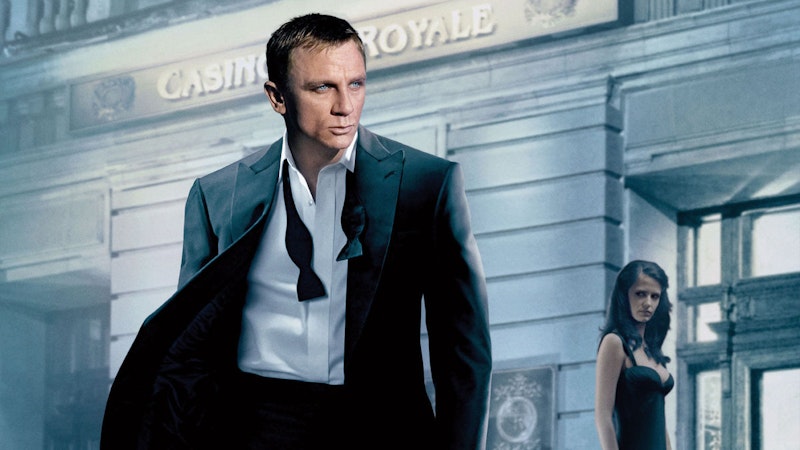The many faces of James Bond in film have alternated between grim blunt instruments (as creator Ian Fleming first described the character) and suavely aloof aristocrats. Pierce Brosnan played Bond as an elegant archetype, but to his chagrin, producers Barbara Broccoli and Michael G. Wilson decided to move in another direction after his four-film contract was up, and reboot their franchise. Which might have had to do with the fact that MGM had finally acquired the rights to Fleming’s first Bond novel, Casino Royale.
The resulting film, released in 2006, consciously shuns the high-tech shenanigans of 2002’s Die Another Day. Gadgetmaster Q doesn’t even appear. The material of the book requires a grimmer tone, as Broccoli observed: “He’s tortured in one of the worst ways imaginable, so it’s really hard to make that fun.” The plot of the novel’s expanded in a number of ways, reconceived as an origin story for Bond; it begins with a pre-credit sequence in which he earns his license to kill, and then goes on from there.
After a chase in Madagascar turns into a breathtakingly kinetic parkour sequence, Bond tracks down a corrupt Greek official who hired a bomb-maker to destroy an airliner as part of a scheme to manipulate the price of stock shares. Thwarting that scheme means the mastermind, a sinister banker named Le Chiffre (Mads Mikkelson), loses a vast amount of money he owes to the African Lord’s Resistance Army. Desperate to make the money back, Le Chiffre stages a winner-take-all poker tournament for the ultra-rich. Bond’s sent to take part, undercover, and bankrupt Le Chiffre for the final time.
What happens after that—the outcome of the tournament, Bond’s torture by Le Chiffre, the aftermath with Bond’s ally Vesper Lynd (Eva Green)—is roughly similar to the book. The novel opens with Le Chiffre in financial trouble and the tournament about to start; it’s a clever structural idea to use the first part of the movie to show the downfall of Le Chiffre’s financial empire, and also to make that downfall due to Bond’s efforts. The sequence of events holds together well in its broad outline (leave aside the question of whether staging a poker game is the best way for Le Chiffre to make quick cash).
Scripters Neal Purvis and Robert Wade return from the last couple of Bond films, joined by Paul Haggis. Director Martin Campbell, who helmed GoldenEye, is back and brings a sure touch. European wealth has a visual texture of elegance, torture is dark and underlit, action scenes are dazzling. Campbell knows how to move the camera to emphasize the movement of actors on screen, how to establish geography, how to pace a chase scene and build a fight.
And Daniel Craig takes over the title role. His Bond is a new agent, young and aggressive in ways even Connery’s Bond never was, not yet the unflappable cold-as-ice assassin we’ve come to know. He’s not as knowledgeable as previous Bonds, not as classy, not as smart. Not an aristocrat. One character refers to him as a “maladjusted young man,” and that fits. For once, the genius villain doesn’t feel overmatched by Bond; here, the evildoer who knows the odds down to the last decimal works as a direct contrast to a reckless risk-addicted Bond.
Craig handles the dad jokes any Bond throws out with a kind of understated aggression. On the page the laugh-lines would look like standard Bond repartee. They don’t play that way on screen.
It fits with the back-to-basics tone of the movie, adapting a Fleming text for the first time since 1987’s The Living Daylights. There’s a sense of the franchise reinventing itself on more than a plot level. By the end, what Bond’s suffered physically and emotionally have moved him well along the path from being a brash youth to being the 007 of earlier films.
There are some issues, though. The plot leaves some mysteries open, beginning a somewhat shambolic arc that would cover all five movies Craig would make as Bond. While the film stands alone, it also leads directly into further adventures, and those adventures aren’t all as strong as this one.
A bigger problem is that with this movie the Bond films are again chasing the cinematic zeitgeist instead of pushing the action-movie envelope. You can see the Jason Bourne movies here—the first two had come out when Casino Royale was being made—and you can see a lot of 2005’s Batman Begins. These are self-referential influences, in that those movies were themselves influenced by the Bond franchise (Christopher Nolan’s a big Bond fan). But they’re also logical influences. If Batman Begins provided a roadmap for how to reboot a flamboyant character with a minimum of camp, Casino Royale at least follows that map with some flair.
On the other hand, by definition this movie risks losing what makes the Bond films distinctive. It removes excesses; it’s one of those Bond movies that function as a corrective to the preceding installments. This risks creating a generic action film, lacking the distinctive weirdness of Bond espionage.
That never happens, thanks to Campbell and Craig. Craig does a lot with a character who begins the film consciously keeping people on the outside, and who becomes less trusting as the story goes on. Campbell keeps the story moving, and brings it out in a series of strong visual choices. Casino Royale is in some ways less challenging than Brosnan’s films, which questioned the values of Bond’s employers; there’s a gloss of grittiness here that hides a return of sureness, an ebbing of cynicism about the British Empire. But it also raises interesting if uncomfortable questions about Bond himself, about how a thuggish young man can become the polished figure we’ve come to know—and what kind of trauma birthed James Bond.

